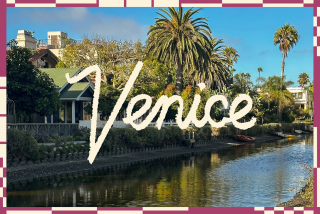Ancient Boats Wearing Out Faster Than They Can Be Built : Gondolas Facing Rough Seas in Venice
- Share via
VENICE, Italy — In Venice today, tradition lives--and perhaps dies--in a litter of weathered wood and beaten earth along a backwater canal.
Nedis Tramontin works there, and he is old-fashioned--no apologies. He wields a fine-honed ax that belonged to his grandfather. His measuring stick is not a yard, or a meter, but a paso Veneto , the standard measure used 500 years ago in the Most Serene Republic of Venice.
Tramontin’s workshop is hard to find, but every gondolier in Venice knows it--with reason. A couple of times each year a lopsided slice of high-prowed beauty--and of narrowing history--slides out of his old shed into the dark canal water.
“All wood. All by hand. There are no shortcuts,” said Tramontin, and he should know, for he is the last of Venice’s master gondola makers. The sinewy Tramontin, bifocals on his nose, blueprints in his head, is the proud survivor of a vanishing breed of European craftsmen.
It is an uneven struggle. About a thousand years after residents of marshes and islands hereabouts invented an agile, flat-bottomed rowboat to ply their shallow lagoon, the Venetian gondola is an endangered species.
Gondolas are wearing out faster than they can be replaced by the few Venetians who build them. In addition, modern materials and elements of mass-production technology increasingly find their way into new gondolas, changing the essence of boats whose design hasn’t changed since the 1600s.
At Tramontin & Sons, founded Feb. 2, 1884, a gondola is custom built for a specific gondolier from carefully chosen boards of fir, larch, cherry, walnut, elm, oak, lime and mahogany.
Patching the Prow
“In all we use 280 different pieces of wood, give or take a few,” said Tramontin, feathering a patch into the prow of a gondola damaged in an encounter with a vaporetto, one of Venice’s water buses.
Except at Tramontin’s these days, marine plywood is the rage for gondola hulls. Can fiberglass be far behind? Would a gondola made of fiberglass really be a gondola? Tourists might not know the difference, but Venetians would.
“I fear the gondola is destined to disappear. Each year the fleet dwindles as old gondolas are scrapped without replacement,” said Guglielmo Zanelli, an Italian navy commander and co-author of a history on gondola construction. “Gondola making is a skill that is dying. If there are no makers, there is no future. Tramontin is the last of his generation.”
The numbers are unpleasant. Gondolas, which for centuries were Venice’s answer to the horse and buggy, numbered about 5,000 in the 1700s, according to Zanelli. Today, there are perhaps 440 gondolas shared among about 500 licensed gondoliers, according to Silvio Testa, a young Venetian journalist and volunteer at the government-supported Assn. for the Protection of the Gondola and the Gondolier.
“The greatest change has been not so much in the numbers but in the quality of new construction. Tramontin is the last traditionalist. He believes gondolas can’t be standardized or identical,” Testa said.
In the days of oars and sail, a gondola lasted about 30 years. Today, buffeted round the clock by the wash of motorboat traffic, a decade is a more typical lifetime, although Tramontin says he can re-hull one of his boats after 10 or 12 years and send it back out to sail for as long again.
There are now six squeri, or boatyards, in Venice where gondolas are built. Their annual production is about 25 boats. Tramontin, 67, and his partner and son Roberto, 34, delivered a gondola last spring that had been ordered in 1980.
With back orders for more than 40 boats, the Tramontins figure it will take until 2010 to build them. Most of their year is occupied with repairs. They build only two or three new boats a year, mostly in the winter, at a cost of about $12,000 each. To that, a gondolier must add another $3,000 to $4,000 for decorations and furnishings.
“We need more boats and more builders. We need apprentices to learn the skills. Tramontin and the remaining masters who have retired are all approaching 70,” said Palmiro Fongher, who is one of Venice’s most famous gondoliers. One recent Sunday afternoon, Fongher, 56, and fellow national hero Sergio Taliapietra, 53, coolly beat back challenges from eight crews of brawny gondoliers 30 years their junior to win Venice’s coveted Historic Regatta.
At the end of the 19th Century, there were 15 prominent families of gondola makers in Venice, Zanelli says. One by one they dropped away as Venetians swapped their gondolas for motorboats and cars secreted in mainland garages. Since World War II, Venetians have ridden gondolas principally for weddings, funerals and civic festivals like the regatta.
Nowadays, except for ceremonial craft and a small fleet used as ferries at eight public canal crossings, gondolas are the darlings only of Venice’s 6 million annual tourists. City hall says a ride shouldn’t cost more than $1 per minute for a party of five, but not all of Venice’s gondoliers believe that.
About the only enduring consensus among a historically disputatious gondola clan, in fact, is on the color of their boats. Venetian gondolas have been uniformly black since the ruling Doges, wearied by the excesses that patrician families squandered on their runabouts, decreed the color in a sumptuary law on Oct. 8, 1562.
Recent efforts to encourage local interest with a gondola museum, and to spur new construction with a school for apprentices, have fallen flat, leaving the gondola’s future low in the water.
More’s the pity. For Venetians, the gondola is more than just a symbol of their unique water city. It is the very stuff of its soul.
“Something has to be done. If the gondola disappears, Venice dies. I can’t believe that could happen,” Fongher said.
Components of gondolas have assumed lives of their own. The forcole , that distinctive oarlock carved from a solid block of walnut and looking like an arm bent at the elbow, is so alluring that it is displayed as modern sculpture in museums around the world.
Legend swirls around the gondola’s imposing ferro , its six-toothed metal prow. Percy Bysshe Shelley, in an unpoetic moment, likened it to “a nondescript beak of shining steel.”
Happily for its aura of mystery, no one can say for sure exactly what the ferro stands for, but the conventional wisdom among gondola fanciers is that the six teeth represent the six neighborhoods of Venice. Above them sits a crest that stands for the Venetian island of Giudecca. The double curves of the ferro suggest the snaking course of the Grand Canal.
Weight Is Important
For Nedis Tramontin, son of a gondola-making son of a gondola maker, the ferro means 28 pounds if it is made of iron, but only about half that if it is newfangled aluminium. The weight is important, for it must be factored into the overall scheme of a craft for which Tramontin never draws a plan.
“The lighter the gondolier, the higher the bow. The heavier the gondolier, the higher the poop,” recited Roberto Tramontin, who has been building gondolas with his father for 20 years and says, “I’m about one-quarter as good as the old man.”
When a Tramontin gondola is finished, it is 35.54 feet long--36.41 with the ferro --and weighs about 1,100 pounds. It draws eight inches and lists markedly to starboard when empty.
If a line were drawn lengthwise down the middle of a gondola, the two sections would not be equal. The port, or left, side would be some nine inches wider and about one inch higher. The weight of the gondolier, standing in the stern on the port quarter, his single oar slung to starboard, instantly rights a well-made boat to an even keel.
Figuring out how a gondola is put together is no task for an outsider. The voluble senior Tramontin, his Italian bobbing atop the “z”-heavy, “l”-swallowing Venetian dialect, remembers a British naval architect badly bit by the gondola bug.
The architect wanted to see one built from the ground up, it seems, and so he came to the squero every day with his measuring tools, his camera, his drawing board and T-square. He watched with fascination and well-mannered perplexity as the gondola took shape until one day when Tramontin offhandedly reached into a dusty corner for a bit of wood that he had cut weeks before and, bang, just like that, slid it into place.
“This Englishman! He threw up his hands in disgust, and he left. We never saw him again!”
Roberto Tramontin, repainting the deck of a wedding gondola, joins his father’s laughter. His own skill is considerable, and his commitment total. Waiting for what he hopes will be his first son, the younger Tramontin is already making plans.
He pictures the boy: He’ll have a measuring eye, slick hands and grit enough to build genuine Venetian gondolas deep into the 21st Century, plywood and fiberglass be damned.
More to Read
Sign up for The Wild
We’ll help you find the best places to hike, bike and run, as well as the perfect silent spots for meditation and yoga.
You may occasionally receive promotional content from the Los Angeles Times.






